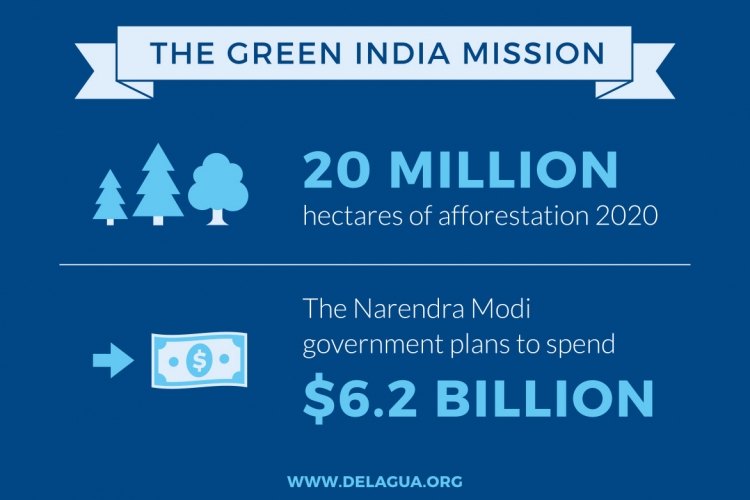NATIONAL GREEN INDIA MISSION: a study
In News:
A study looks critically at India’s National Mission for a Green India, arguing that contemporary afforestation goals set under such a mission “assume arbitrary targets” that are rooted in habits of “(neo)colonial governance” rather than “sound science”.
GREEN INDIA MISSION
The Green India Mission is one of eight missions under the National Action Plan on Climate Change and aims at “protecting, restoring and enhancing India’s diminishing forest cover and responding to climate change by a combination of adaptation and mitigation measures”.
It envisages a holistic view of greening and focuses on multiple ecosystem services, especially, biodiversity, water, biomass, preserving mangroves, wetlands, critical habitats etc. along with carbon sequestration as a co-benefit. This mission has adopted an integrated cross-sectoral approach as it will be implemented on both public as well as private lands with a key role of the local communities in planning, decision making, implementation and monitoring.
Mission Goals
-
To increase forest/tree cover to the extent of 5 million hectares (mha) and improve quality of forest/tree cover on another 5 mha of forest/non-forest lands
-
To improve/enhance ecosystem services like carbon sequestration and storage (in forests and other ecosystems), hydrological services and biodiversity; along with provisioning services like fuel, fodder, and timber and non-timber forest produces (NTFPs)
-
To increase forest based livelihood income of about 3 million households.
Report from study
The $7billion environmental intervention, laid out in 2011, seeks to put a third of the country under forest cover by increasing forest and tree cover .
“Ostensibly aimed at improving forest-based livelihoods, the initiative has all the qualities of past forestry efforts in India, which have historically performed a reverse role: disinheriting forest-rooted populations,” the study states.
The study notes that for over two centuries, “afforestation has been viewed as a panacea for a variety of ills including civilizational decline, diminished precipitation, warming temperatures, soil erosion, and decreasing biodiversity”. “Given that forest cover of Europe in the colonial period was estimated at roughly one-third, and that this region serves as the source of knowledge, law and statecraft, afforestation rate of 30-33% became the widely accepted minimum for civilization.India, this targeted minimum, became a conceptual ghost that haunted successive generations of forest policymakers, whose goals might have been diverse but whose mechanism represent a disordered form of repetitive method, imposed over and over on arid and semi-arid ecosystems and the local communities who knows them best,” it states.
In other words, the report suggests the forest policy makers repeatedly failed to use the local knowledge to develop forests which is a colonial mindset ending up in not achieving the actual objective.
It says the “obsession” with tree-planting has its roots in the colonial forestry bureaucracy. “The British learned this habit, which pervade the pages of the Indian Forester years before independence, from the French, it turns out. A generation of British foresters were trained in Nancy France in the late 19th century. There, they learned what French colonial policies were in Africa: plant trees to cure the ‘runaway’ deforestation and grazing habits of local people, especially pastoralists,”
The study argues that the approach to forestry in India has been “flawed”. For instance, commitment to fixed rates of forest cover encourages tree plantations in “ecologically inappropriate sites and conditions”. Again, afforestation typically extends the “authority” of Indian state forest departments in a way that is mostly “at the expense of local livelihoods” rather than in “support of them.” One problem of plantation ecologies in India, according to the study, is “enthusiasm for fast growing species and exotic and invasive species, planted in the name of increasing land cover dedicated to ‘forest’.”
Does tree-planting really lead to greening? tree-planting is NOT greening. Greening would take a socio-ecological approach that treated the system as a whole, a ‘Restoration Ecology’ of grasslands, streams, mixed scrub, agroforestry, and so on. The incredible and beautiful diversity of the Indian ecological mosaic deserves a true ‘greening’ approach, that takes seriously the genius loci, the peculiarity of local systems, and restores these with local people.”
Other programs and conclusion
The larger point that the study aims to rethink India’s approach towards afforestation and not do what others do for the sake of doing.This has to be kept in mind for other afforestation programmes like CAMPA, Green India Mission, National Afforestation Programme, as well as plantation along highways and railway tracks,green skill development initiatives and environmental info systems and a holistic interconnected approach shall help India attain its environmental goal.


 IAS -2025 Prelims Combined Mains Batch - III Starts - 14-04-2024
IAS -2025 Prelims Combined Mains Batch - III Starts - 14-04-2024